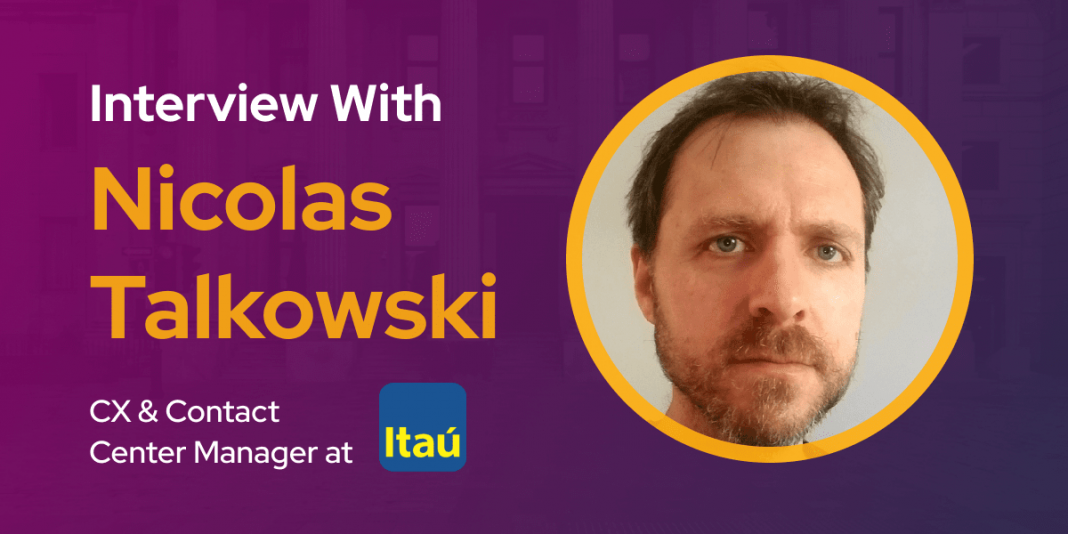Hi Nicolas, tell us about yourself and your background.
Well, I am forty-seven years old, I’m married and I’ve got two children. I studied Industrial Engineering and I also have a diploma in Technological Services Management.
I have worked in the telecommunications industry for seventeen years, reaching managerial positions in Customer Care Processes and Project Management Office. During the last four years, I have been the Head of Customer Experience at Banco Itau in Argentina.
Besides my formal education, I am specialized in Process Improvement, Customer Experience and Ontological Coaching.
How did you start working in the customer experience space?
My first approach to the CX space was in 2013, when the company I was working at started a strong cultural change introducing the NPS system. I was the Customer Care Process manager, so I had to be very involved in that process, because of the impact my team’s decisions had on the customer experience. After that, I took my first formal education on CX and a couple of years later I had the responsibility to manage the strategic projects portfolio, including all the experience improvement initiatives.
In 2017, Banco Itau Argentina was planning to start the fascinating journey of becoming a customer-centric company, and they needed leaders to take part of it, so I accepted the challenge and started the project from scratch.
What do you think the top priority should be for a company that wants to improve its customer experience?
In my opinion, improving the customer experience of a company requires a program that should act in four areas.
- First of all, you need a measuring system. It’s important to be able to clearly identify which are the main pain points of your customers. And the only way you can do that is asking them. You can choose the KPI you prefer (NPS, CSAT, CES), but it’s really important that you can get customer feedback on most of the company touchpoints. Measuring lets you work on what is objectively important for your customer, instead of working on what some leaders think the main problems are. Besides that, a measuring system gives you the information about the success of your transformation plans.
- The second thing you need is a formal reward program for the people who are face to face with your customers. You will never improve your customer experience if you don´t let those people know that doing the things right in the good experience direction is better for them than doing them wrong. Employees usually spend more energy on what they are paid for. So you need to pay for better results on customer experience.
- The third area you have to work on is your internal processes. Most companies have processes that were designed thinking in their own needs, instead of their customers’ needs. To work on this point, it’s important to have interdisciplinary teams (that can also include customers) and use Design Thinking tools to reach “out of the box” solutions that can transform your customer experience.
- The fourth thing you have to work on is the Customer Centricity internal culture. Improving the customer experience is not only a job for the people who work on the Contact Centers or the Customer service. It’s a whole company responsibility. So if you want to have success in your customer experience program you’ll need to involve them all.
But the most important thing you need to get success in this kind of transformation is the C-level commitment. They have to be the main sponsors for the program. Without their support it won’t be able to make it.
How can companies better listen and understand their customer base?
At this point, I like to use a concept that I learned about knowledge. Knowledge can be divided into four sections: The things “you know that you know”, the things “you know that you don’t know”, the things “you don´t know that you know” and “the things you don’t know that you don’t know”.
Most companies base their decisions on the first category of what they know about their customers. That is the information they have in their business intelligence reports. That kind of report can give them information about the different interactions their customers had with the company, but they don’t give information about how that interaction was in terms of customer experience. So, companies need to have a feedback system to get that information. Those are the things “you know that you don’t know”. You don’t have the answer, but you have the question and you can ask your customer about it.
But companies also have things that they “don’t know that they know”. There’re employees in different parts of the company who have important information about customers’ behavior which is critical to design better experiences, and nobody asks them about it. So, besides listening to your customers, it’s also important that you make that knowledge reach the decision levels. You have to listen to your own employees. That is part of your “customer voice” too.
Finally, companies need to understand that there are many things they don´t know about their customers but they don’t even know that they ignore. That part of their customer information is full of important business opportunities and you can’t miss it. The use of quality studies such as focus groups, individual interviews and customers communities are important tools to complete the customer voice map.
Many companies are currently undergoing digital transformation processes – what are your tips on a successful digital transformation?
Digital transformation is not only about using digital technology. Never forget Steve Jobs’ words: “You’ve got to start with the customer experience and work backwards to the technology. You can’t start with the technology and try to figure out where you’re going to sell it”. That’s the main point, because currently we can make almost anything we want with digital technology. But first, we need to decide what kind of experience our customer needs, and then choose the technology that better fits it.
Another important thing is that a Digital Transformation is about Mindset transformation. You can’t make a digital transformation if you have analogical brains in your teams. Companies need to work on their people skills if they really want to improve their Customer Experience through a digital transformation. Otherwise, it will be just a waste of money.
What are some CX companies and solutions you’re keeping your eyes on right now?
I always loved the Amazon shop experience. The way they solve all the parts of the shopping journey, from the decision moment until the product delivery it’s really great. I´m also a great fan of Uber and Airbnb, giving excellent experiences without needing to pay more for the services. The Disney Experience is another great example, because it’s about involving the whole company staff as part of the magic.
What are some of your tips for people who want to work in the CX sphere?
The CX sphere has multiple areas where people can work on. So, the first tip I could give is to try to figure out which are your strengths. If you have analytical skills, and you like data science, there are excellent possibilities in customer voice programs, finding customer insights with the use of surveys and statistics. But if you feel more comfortable using your soft skills and the power of human relationships, you could be a great leader for a Customer Centricity Culture program. Finally, if you feel you´re a process improver, you like projects and the technology, there are lots of things you can do in terms of Digital Transformation.
Another tip I could give is to always keep a critical thinking. The Customer Experience is a new discipline, so we are all writing the principles while we work on it. Nobody has the truth and something that could work in one company could not work in another. So be open-minded.
The last tip is that you need to understand that any change in a company is a culture change. And culture changes involve people. Never underestimate the resistance to change. These kinds of programs need time, because people need time to change. Never forget that.
So many things changed in 2020. While some things are going to return to “normal,” what are new trends and habits you think will stay with us in the long term?
Well, I think that remote interactions between companies and customers is something that has increased during the last year and I think that it will not return to the previous situation. People who used to be far from those kinds of contacts have realized that they make their life better and simpler. I think that is something that will stay with us.
The other trend is about the way we work. 2020 showed us that we could work in a remote way without losing productivity and reaching our goals anyway. I am sure that our jobs will be different from now on, with a mix between home office and company office.
You can see that both trends are related one to the other. Because more remote interactions allow more home office for the employees. And if country laws and regulations accompany, we will start seeing more people living in the part of the world they want, no matter where the office is and buying products online to the company they prefer. And that will be a great revolution in terms of customer and employee experience.
So, it’s not just about the things that are here to stay. It’s about the revolution that’s coming and the challenges that it brings for all of us.
eCommerce boomed in 2020, and consumers started leaving more product reviews online. How can we make the most out of this momentum?
When I talk to people about the importance of Customer Experience, I always use the same example: Nowadays, nobody chooses a hotel for holidays reading the information from the hotel web page. Most of the people read the comments made and watch the pictures taken by real passengers. That is because we do not trust traditional marketing, we prefer to make our decisions based on other people’s real experiences.
With the strong growth of ecommerce during the last year, it is very much important for the companies to invest their money in social marketing and in answering bad reviews rather than spend money in traditional marketing campaigns. Because customers are online, reading comments, making video reviews and that is what actually builds our products and companies reputation. If we have the ability to get into those social conversations in a valuable way for our customers, we can build a better relationship with them and the risk may become a great opportunity.
What is your favorite CX metric? Why?
I don’t have a favorite metric, because different metrics can be used in different situations.
But, if I have to choose, I like using two metrics. The first is Customer Effort Score. It’s a great metric to evaluate the UX in transactional processes, especially in digital interactions. Customers want simple and intuitive operations and that has a strong correlation with the complete Customer Experience. In my opinion, the CES is the metric that better represents the success of our UX.
The other metric that I use is the NPS. Although I think there are some cultural aspects that can affect the strength of the metric when you want to make comparisons (especially between different countries), the NPS moves companies towards the action very much more than other kpis like CSAT. That is because while CSAT can change from an 80% to a 75% when you are not doing things right, NPS can fall from positive to negative values. And no one in a C-level board wants to see negative values in a report.
So, my choice is: NPS to measure relational experience and CES for transactional.






